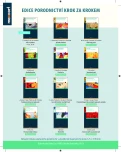-
Medical journals
- Career
Contraceptive vaccinogen – current state of development
Authors: J. Cibulka
Authors‘ workplace: Gynekologicko-porodnická klinika LF UK a FN, Plzeň, přednosta doc. MUDr. Z. Novotný, CSc.
Published in: Ceska Gynekol 2014; 79(1): 12-15
Overview
Objective:
To present an overview of published results of research and practice in the field of searching for the contraceptie vaccinogen.Design:
Review article.Settings:
Department of Gynecology and Obstetrics, Medical Faculty in Pilsen, Charles University in Prague and University Hospital in Pilsen.Objective of study:
The issue of fertility is a growing problem especially in developed countries. The questions of contraception in terms of family planning are intensively discussed. Regardless of the unfavorable development of the number of the population in developed countries, various kinds of contraceptives are still in demand. The widespread availability and reliability confirms a dominant position of hormonal contraception. Due to the known and contemplated negative effects of hormonal contraceptives on the individual as well as on the environment, the immunological aproach offers to become an option with long lasting effect. Therefore it is not surprising that research on contraceptive vaccinogen is most supported in countries such as China or India.
Experiences in research and treatment of otherwise unexplained infertility are also applicable in opposing intentions as immunologically induced down-regulation of fertility.Conclusion:
Long term research of immunogenicproperties of human sperm indicates, that the possible induction of an immune response to this gametes currently appears to be the safest and also the most difficult way to achieve immunological contraception potentially in both, man and woman.Keywords:
reproductive immunology – contraceptive vaccinogen – hormonal contraception –sperm antigens – antisperm antibodies
Sources
1. Aitken, J. Immunocontraceptive vaccines for human use.J Reprod Immunol, 2002, 57, p. 273–287.
2. Bertin, A., Inostroza, PA., Quiñones, RA. Estrogen pollution in a highly productive ecosystem off central-south Chile. Marine Pollution Bulletin, 2011, 62(7), p. 1530–1537.
3. Gupta, SK., Gupta, N., Suman, P., et al. Zona pellucida-based contraceptive vaccines for human and animal utility. J Reprod Immunol, 2011, 88(2), p. 240–246.
4. Haider, Z., D‘souza, R. Non – contraceptive benefits andrisks of contraception. Best Pract Res Clin Obstet Gynaecol, 2009, 23(2), p. 249–262.
5. Hu, X., Shi, W., Cao, F., et al. Bioanalytical and instrumental analysis of estrogenic activities in drinking water sources from Yangtze River Delta. Chemosphere, 2013, 90(7), p. 2123–2128.
6. Kolpin, DW., Furlong, ET., Meyer, MT., et al. Pharmaceuticals, hormones, and other organic wastewater contaminants in U.S. streams 1999–2000: a national reconnaissance. Environ Sci Technol, 2002, 36(6), p. 1202–1211.
7. Levy, JK., Friary, JA., Miller, LA., et al. Long-term fertility control in female cats with GonaCon™, a GnRH immunocontraceptive. Theriogenology, 2011, 76(8), p. 1517–1525.
8. Mclaughlin, EA., Aitken, RJ. Is there a role for immunocontraception? Molecular Cellular Endocrinol, 2011, 335(1), p. 78–88.
9. Mohllajee, AP., Curtis, KM., Martins, SL., et al. Hormonal contraceptive use and risk of sexually transmitted infections: a systematic review. Contraception, 2006, 73(2), p. 154–165.
10. Naz, RK. Contraceptive vaccines. Drugs, 2005a, 65, p. 593–603.
11. Naz, RK. Development of genetically engineered human sperm immunocontraceptives. J Reprod Immunol, 2009, 83(1–2), p. 145–150.
12. Naz, RK. Female genital tract immunity: distinct immunological challenges for vaccine development. Journal of Reproductive Immunology, 2012, 93(1), p. 1–8.
13. Rempel, MA., Schlenk, D. Effects of environmental estrogens and antiandrogens on endocrine function, gene regulation, and health in fish, in International Review of Cell and Molecular Biology, W.J. Kwang, Ed. 2008, Academic Press. s. 207–252.
14. Talwar, GP., Singh, O., Pa, LR., et al. A vaccine that prevents pregnancy in women. Proc Natl Acad Sci USA, 1994, 91,p. 2532–2536.
15. Tung, KSK., Lou, Y., Bagavant, H. Zona pellucida chimeric peptide vaccine. In: Gupta, S. ed. Reproductive Immmunology. New Delhi, India: Narosa Publishing House, 1999, p. 303–308.
16. Wikipedia. Světová populace [online], [cit. 15.2.2013] Dostupné z http://cs.wikipedia.org/wiki/Sv%C4%9Btov%C3%A1_populace, 2013.
17. Yan, Z., Lu, G., Liu, J., et al. An integrated assessment of estrogenic contamination and feminization risk in fish in Taihu Lake, China. Ecotoxicol Environment Safety, 2012, 84(0), p. 334–340.
18. Zhang, A., Li, J., Zhao, G., et al. Intranasal co-administration with the mouse zona pellucida 3 expressing construct and its coding protein induces contraception in mice. Vaccine, 2011, 29(39), p. 6785–6792.
Labels
Paediatric gynaecology Gynaecology and obstetrics Reproduction medicine
Article was published inCzech Gynaecology

2014 Issue 1-
All articles in this issue
- Detection of cancer stem cells in ovarian cancer
- Contraceptive vaccinogen – current state of development
- Effect of overweight on the outcome of assisted reproductive technology in infertile women
- Sperm mitochondrial function in men with normozoospermia and asthenozoospermia
- Oral health status of women with normaland high-risk pregnancies
- Severe postoperative bleeding after Total Prolift procedure for vaginal vault prolapse – case study
- Androgen insensitivity syndrome – case report
- Results of perinatal care of pregnant women with diabetes in Western Bohemia
- Analysis of point mutations in interleukin-11 gene in the population of infertile patients and fertile control women
- Czech registry of complications in gynecological laparoscopy – the on-line data collection
- Non-neoplastic epithelial disorders of the vulva – lichen sclerosus
- Ritgen maneuver and its modifications
- Comparison of hysterectomy techniques in a group of patient operated for the diagnosis female to male transsexualism
- Czech Gynaecology
- Journal archive
- Current issue
- Online only
- About the journal
Most read in this issue- Non-neoplastic epithelial disorders of the vulva – lichen sclerosus
- Androgen insensitivity syndrome – case report
- Severe postoperative bleeding after Total Prolift procedure for vaginal vault prolapse – case study
- Comparison of hysterectomy techniques in a group of patient operated for the diagnosis female to male transsexualism
Login#ADS_BOTTOM_SCRIPTS#Forgotten passwordEnter the email address that you registered with. We will send you instructions on how to set a new password.
- Career

